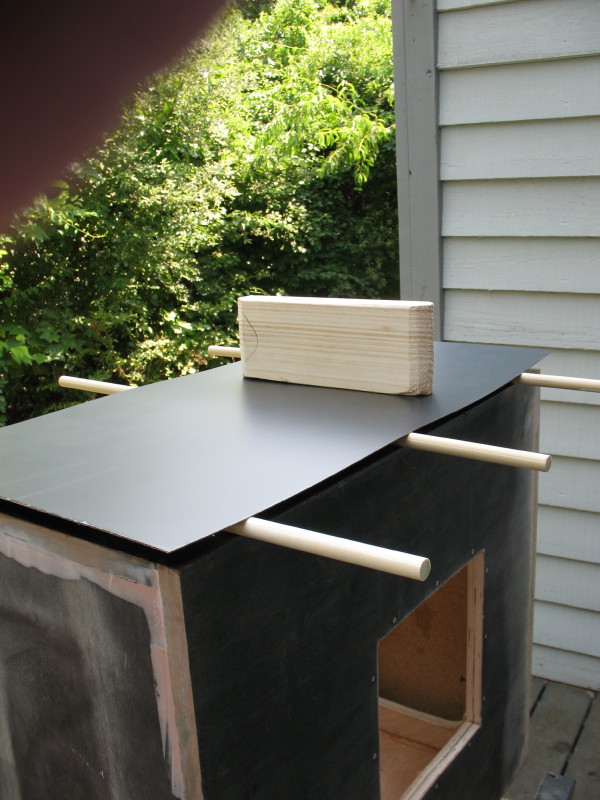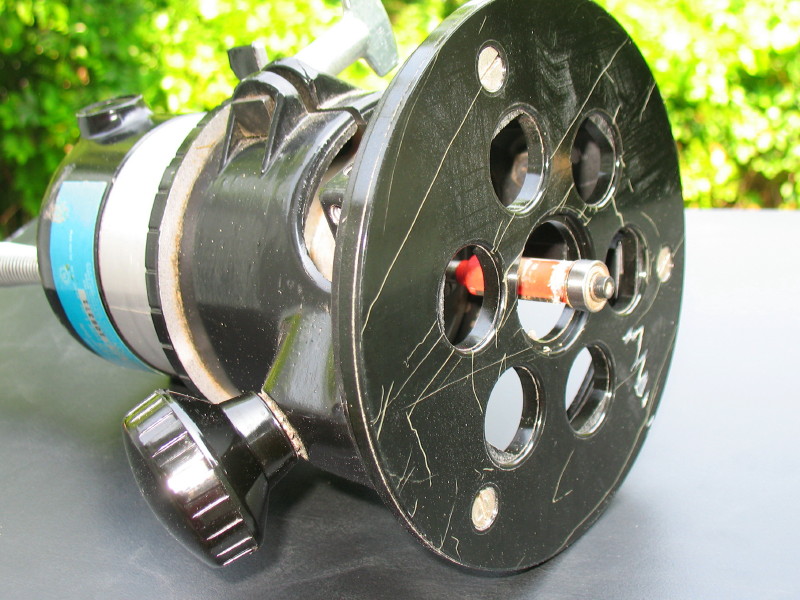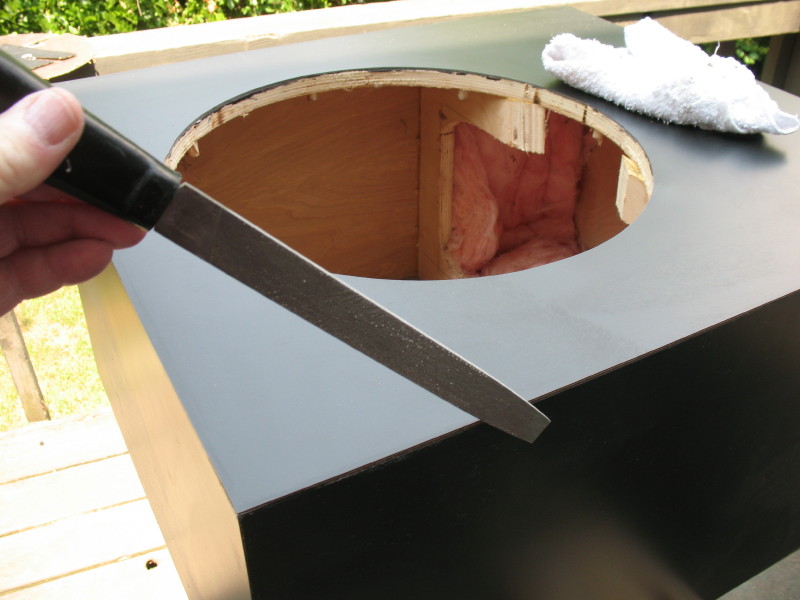| More on Formica Cabinets [message #68114] |
Thu, 09 June 2011 14:23  |
 Bill Epstein
Bill Epstein
Messages: 1088
Registered: May 2009
Location: Smoky Mts. USA
|
Illuminati (2nd Degree) |
|
|
The Formica is cut, the cabinets are re-furbed with low spots filled and leveled and screw holes doweled. Time to move outside and begin the inhalation of toxic fumes!
Just like with the NBL wood veneer, 2 coats of contact adhesive go on both surfaces, waiting for each coat to dry enough so that, while tacky, your finger will not pick any up. BTW, when applying the adhesive, go a little heavier on the edges of the workpiece which always seem to cause problems otherwise.
Now the dowels get placed to keep the glued surfaces apart during alignment. Different strokes, here, but I use dowels because of their minimal contact with the surface which makes pulling them out easier. 1/2" dowels seem to be the optimum size: large enough to maintain the separation, small enough to allow the eyeball to get a good picture of the alignment.

When I line up the Formica or veneer, I take my time and walk around as many as 3 times, double-checking after each minor re-position that a movement one way hasn't left a gap in another. There's only one chance to get this right!

Once aligned, I remove an inner dowel to start. The soft pine wood block, cut from an ordinary 2X4, is the "squeegee" I use to press the 2 surfaces together, working outward from the center and paying special attention to the corners. The edge of the pine is soft enough to not mar the workpiece but narrow enough to exert a fair amount of pressure to eliminate the possibility of bubbles.
Once the dowels are gone and the Formica well-fastened, it's time to get out the router and flush trim bit. Unlike wood veneer, Plastic Laminate doesn't take well to trimming with even a really sharp plane and the router bit is necessary. There are knives in special holders sold, ostensibly, for this use but in reality they only work well on hot-melt edge banding.

Keep the Lacquer Thinner handy, you'll need to clean the glue goop from the router bit after every pass. It's also good for the inevitable finger or tool in the glue. A light touch is required on the router just to keep it level and moving on the workpiece. Too much force or stops and starts will result in angle changes and scalping the adjacent surface. Ask me how I know....don't ask.
Once trimmed, the laminate needs a smoothing with a Mill Bastard file held at an angle and passed across and down in several passes on each edge. Always work from tip to handle and back again, never back and forth. One pass should be enough; it's just to smooth any burrs the router left.

A rag soaked with lacquer thinner and fingertips to roll up the rubbery glue left behind are the final clean-up. Be careful not to get thinner down into the workpiece.
And finally, here is the finished cabinet ready for the driver and plate amp. One down, one to go, next day off.

|
|
|
|
| Re: More on Formica Cabinets [message #68115 is a reply to message #68114] |
Thu, 09 June 2011 14:55   |
 |
 Wayne Parham
Wayne Parham
Messages: 18985
Registered: January 2001
|
Illuminati (33rd Degree) |
|
|
That looks really great, Bill.
I had an unusual requirement of the Formica covered cabinets I have. They're little one π speakers that are sometimes used in a car or van. That was their original purpose. I put Velcro on them, which sticks great to the carpet and holds them in place pretty well, preventing them from sliding around. I don't use them often, but if going on long trips in a rented van, it's a nice way to have good music.
The thing is, when used in a "normal" environment, the speakers look great and never cause me any trouble. The finish is very durable and can stand up to anything. Except one thing - when you put them in a car, and then leave it out in the sun for a few hours - the black Formica gets too hot to touch. I'd say it's probably 150° Fahrenheit, maybe more. After a couple days of that, the glue that holds the Formica down starts to fail, and the edges curl up.
Now granted, this is an unusual situation, one that no loudspeaker cabinet should endure. But it's a situation I faced, so I set about trying to solve it. What I found was that if I used an epoxy adhesive at the edges, that seemed to be able to survive the heat. I left the glue that the cabinetmaker used in place, because it did a good job holding the majority of the surface. I didn't re-do the whole cabinet. It was just the edges that peeled up, so I put epoxy under those edges, clamped them and wiped clean. Seems to work, never lifted up again.
Sorry for the semi-off-topic thought. Just wanted to throw that out there, in case you ever run into something like that.
|
|
|
|
| Re: More on Formica Cabinets [message #68130 is a reply to message #68115] |
Fri, 10 June 2011 21:08  |
 Bill Epstein
Bill Epstein
Messages: 1088
Registered: May 2009
Location: Smoky Mts. USA
|
Illuminati (2nd Degree) |
|
|
|
That's a good tip about the epoxy and highlights the "dirty secret" of Contact Adhesive. I keep a tube of "Hot Shot" super glue around for loose veneer at the edges. It isn't just excessive heat, veneer will just sometimes bite you in the ass.
|
|
|
|







